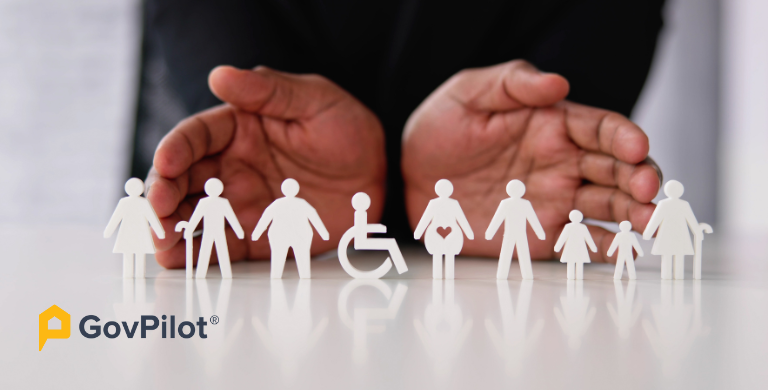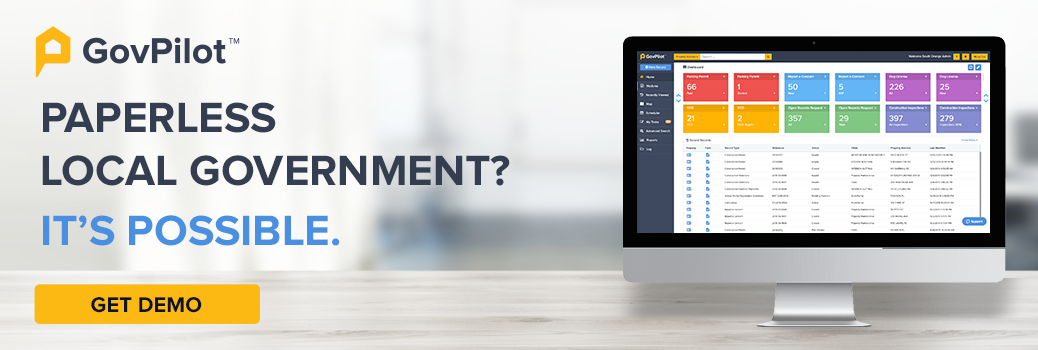In their journey toward inclusivity, local governments are realizing that traditional citizen support models may not cater to individuals of all abilities or backgrounds. This realization brings to light the challenge of empathizing with those who may navigate the world differently than we do.
As government officials strive to enhance accessibility and embrace inclusivity, local governments encounter the significant hurdle of ensuring equal opportunities for all citizens. It's crucial for these governments to grasp the fundamentals of supporting diverse groups, yet the task of where to start can feel daunting. With genuine intentions to achieve prosperity and success within their communities, government officials must prioritize equitable access as the initial step toward achieving this goal.
Understanding the variability in an individual's physical, cognitive, and mental ability is a great first step to ensuring all community members are being considered. This article aims to address all levels of ability and outline the first steps governments can take in an effort to foster an inclusive community; We will touch on how to utilize research tools, raise awareness, and reach a higher quality of life for all citizens irrespective of what tools they may need to achieve it.
Educate Yourself On Various Types of Disabilities
It is vital for local government officials and even employees to remain educated on the areas of disability inclusion that are the most vital. Learn about the key disabilities to look our for and prioritize now:
- Physical Disabilities
Physical disabilities come in all levels of ability and visibility, with every individual’s needs unique to themselves. Those with physical disabilities find difficulty in navigating their environment without help or intervention. Old, outdated infrastructure was oftentimes not built with the needs of those who are differently-abled in mind.
This resulted in buildings without accessible parking, entry points, walkways, or elevators creating an air of unwelcomeness to people requiring different needs. In the cultivation of community, all members should feel as though they are being given thought to and the tools available to them should reflect that.
Learn all about The 2021 Infrastructure Bill: What It Means for Local Governments with our resource.
- Cognitive Disabilities
To have a cognitive disability refers to someone who faces challenges in processing and retaining information. This, again, comes in a myriad of presentations, requiring creativity in implementing tools and aids for these community members. Local governments must conduct mindful screenings of public spaces, assessing for lapses in effective communication and determining weak points that may be benefitted by better communication materials. These materials may look like accessible technology, sensory-friendly environments, or supplemental visual aids.
Ensure your local government website is accessible, readable and shareable!
- Mental Illness
More than 22% of Americans acknowledge living with a mental illness, underscoring the urgent need for accessible spaces, essential therapies, and readily available clinics. The lack of necessary resources is a silent nod to the assumed disinterest in accommodating community members. Mental illness affects people of all socioeconomic status, education, and background but the struggles are felt in lower income households who do not have the financial means to provide the amenities that the individuals may need.
Learn all about Crafting a Vision for Mental Health Wellness in Your Community here.
Why Should Local Officials Make Disability Inclusion A Priority?
Although every government body aspires to be compassionate and supportive of all community members, there can appear to be, at times, pervasive ignorance as the needs of differently-abled individuals are overlooked, neglecting to offer accommodations that promote inclusivity. Local officials are urged to lead with empathy and proactively educate themselves about unintentional exclusion.
Acknowledging citizens of varying abilities and affirming their right to a safe, inclusive community is the initial stride towards transforming operational dynamics. Knowledge is empowerment, and as local governments grasp the 'why', implementing the 'how' becomes more attainable. While governments may feel compelled to create an inclusive space by their own volition, legislation has been passed in the last 20 years that makes many accessibility modifications a requirement.
There are specific regulations and laws that buildings, clubs, and organizations are required by law to observe. These include accessible walkways, available telecommunication for those who have auditory or visual impairments, and convenient, usable transportation. The Americans With Disabilities Act (ADA) serves the differently-abled community to guarantee necessary accommodations to the public that, without, would make the municipality difficult, or impossible, to navigate.
Want to know more about the ADA Website Compliance Checklist? Here is everything you need to know.
GovTip: Check out these popular modules to make sure you make disability inclusion simpler in your locality:
4 Key Ways To Create A More Inclusive Community For All
Inclusivity doesn’t just happen, you have to make it a reality for the good of your community. Here are a few ways to do so:
1. Raise Awareness
The diverse spectrum of physical characteristics associated with disabilities often leads to a lack of awareness regarding the unique needs of individuals within our communities. By enhancing visibility through campaigns, seminars, or assemblies, we can gain greater understanding and appreciation for the importance of mental health and disability inclusion in our culture.
These initiatives serve as vital platforms for educating community members about the various challenges faced by individuals with disabilities and the significance of creating inclusive environments that accommodate their needs. Through increased awareness and education, we can strive towards a more empathetic and supportive society where everyone feels valued and included.
2. Promote Education Regarding Mental Health In Public Schools
Integrating mental health education into school curricula not only equips students with essential knowledge and coping skills but also plays a pivotal role in fostering a more understanding and empathetic community. By providing students with comprehensive education on mental health, schools empower them to recognize and support their peers who may be struggling with mental health challenges or disabilities.
This proactive approach not only reduces stigma but also promotes a culture of acceptance and inclusivity, where individuals with disabilities feel supported. Moreover, by nurturing a generation that is knowledgeable and compassionate about mental health, schools contribute to broader disability inclusivity initiatives by laying the foundation for a more inclusive and supportive society.
Let’s explore how GovPilot can help you Craft a Vision For Mental Health Wellness In Your Community.
3. Advocating For Change
Advocating for change in policy, especially in supporting mental health awareness and disability inclusive policy, is instrumental in furthering disability inclusivity initiatives. These efforts provide a structured approach to systemic transformation, ensuring that legislation and regulations protect the rights and promote the inclusion of individuals with disabilities across all facets of society.
By making it easier for constituents to access necessary mental healthcare and medical care, policy changes can significantly improve accessibility, accommodations, and support services, fostering a more equitable environment where individuals with disabilities can fully participate and thrive. Furthermore, advocating for policy change not only raises awareness but also mobilizes community support, cultivating a shared commitment to disability inclusivity and social justice.
Consider our guide to Disability Inclusion Planning in Government: Improve Accessibility for All in Your Municipality here.
4. Inclusive Community Design
Inclusive community design prioritizes the needs of differently-abled community members by integrating their requirements into planning, zoning, and infrastructure design processes. This approach ensures that public spaces, buildings, and transportation systems are accessible to individuals with disabilities, facilitating their full participation in community life.
Compliance with physical regulations, such as those outlined in the Americans with Disabilities Act (ADA), is essential to guaranteeing equal access and removing barriers that may impede mobility or participation for individuals with disabilities. Such inclusive design practices foster a sense of belonging and enable all community members to engage in activities and access services with dignity and independence.
Learn How Local Transportation Can Improve Upward Mobility and check out our Planning Module here!
How To Ensure Disability Inclusion In Government Operations
Conducting research on disability inclusion for your municipality is paramount for ensuring compliance with municipal codes governing infrastructure, inclusion, and equity. By thoroughly understanding local regulations, municipalities can prioritize accessibility features such as ramps and parking spaces in public infrastructure to accommodate individuals with disabilities. Additionally, thorough research can inform hiring policies that promote diversity and inclusivity within the community, aligning with the broader goals of equity and accessibility.
By digitizing zoning regulations, government management software enables efficient management and dissemination of information regarding land use, development codes, and zoning ordinances. It facilitates seamless updates and revisions to regulations, ensuring that municipalities remain compliant with evolving legal requirements.
Check out GovInspect to see our real-time inspection update technology!
-
Hold Public Meetings
Holding public meetings offers an opportunity to enhance diversity and inclusion within the community by providing a forum for citizens from various backgrounds to share their perspectives. Through these gatherings, municipalities can gauge public opinion on pertinent issues and identify areas requiring updates to promote inclusivity. By actively soliciting feedback and insights from diverse voices, governments can prioritize initiatives that resonate with the community's needs and aspirations, thereby fostering a more equitable and responsive environment.
Learn how to Manage & Improve Local Public Meetings here.
-
Host Online Polls
Hosting online forums provides an accessible platform for fostering diversity inclusion in the community by enabling constituents from various backgrounds to participate and share their perspectives. By inspiring constituents to engage in online polls and forums, governments can gather valuable feedback on inclusivity-related issues and prioritize initiatives that resonate with the diverse needs of the community, ultimately fostering a more equitable and responsive governance approach.
Transitioning To An Online Capacity can be confusing, learn how GovPilot can help!
-
Form And Support Advocacy Groups
Local governments forming or supporting advocacy groups can significantly aid in disability inclusivity by harnessing the expertise and passion of dedicated individuals who are well-versed in improving disability inclusion. Engaging with these advocacy groups allows governments to gain valuable insights, collaborate on policy initiatives, and implement effective strategies to create more accessible and inclusive communities for individuals with disabilities.
Consider Addressing Challenges Governments Face Moving to an Online Capacity here!
Make Disability Inclusion In Your Locality Your Priority
Local government officials are urged to prioritize updating policies, advocacy efforts, and infrastructure to better support citizens with disabilities. By booking a consultation with GovPilot, governments can explore opportunities to streamline communication with constituents, ultimately enhancing accessibility and responsiveness to the needs of disabled communities. Let's work together to build more inclusive and equitable societies for all.
Disability Inclusion FAQs
-
Why is disability inclusion important?
Disability inclusion is crucial because it ensures that all individuals, regardless of their abilities, have equal opportunities to participate fully in society, fostering diversity, equity, and empathy within communities.
-
How can local governments support citizens with disabilities?
Local governments can support citizens with disabilities by implementing inclusive policies, providing accessible infrastructure and services, and actively engaging with advocacy groups to address the unique needs of disabled communities.
Read On:
- Best Public Sector Software 2023: Ways Governments Use Technology to Save Time & Money
- Government Continuity Strategy 2023: Procedures During a Crisis
- AI in Government in 2023 and Beyond: Bringing Artificial Intelligence to Your Municipality
- What is Azure for Government? Everything to Know
- What is Municipal Software? Understanding Government Software for Municipalities & Counties
- 7 Government Cybersecurity Best Practices 2023: Keep Data Secure & Prevent Ransomware Attacks
- 13 Benefits of Digital Transformation for Local Government 2023
Sources:






